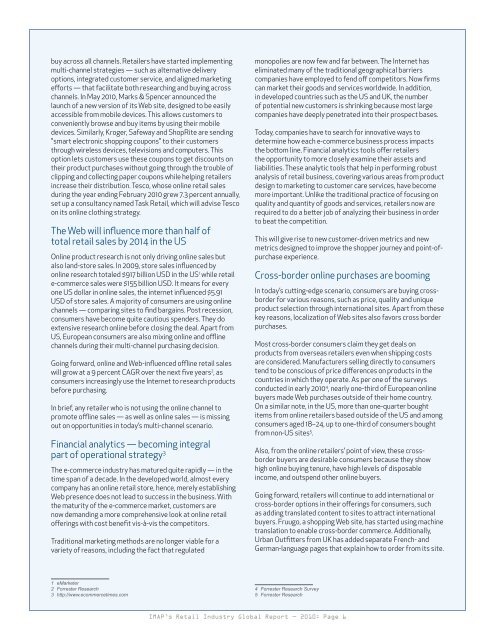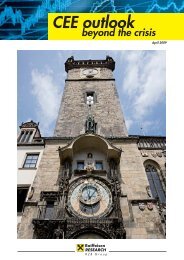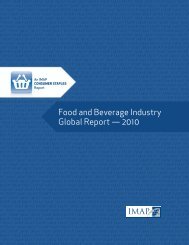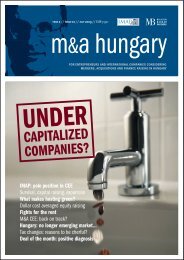Retail Industry Global Report — 2010 - Ascendant Capital Advisors
Retail Industry Global Report — 2010 - Ascendant Capital Advisors
Retail Industry Global Report — 2010 - Ascendant Capital Advisors
Create successful ePaper yourself
Turn your PDF publications into a flip-book with our unique Google optimized e-Paper software.
uy across all channels. <strong>Retail</strong>ers have started implementing<br />
multi-channel strategies <strong>—</strong> such as alternative delivery<br />
options, integrated customer service, and aligned marketing<br />
efforts <strong>—</strong> that facilitate both researching and buying across<br />
channels. In May <strong>2010</strong>, Marks & Spencer announced the<br />
launch of a new version of its Web site, designed to be easily<br />
accessible from mobile devices. This allows customers to<br />
conveniently browse and buy items by using their mobile<br />
devices. Similarly, Kroger, Safeway and ShopRite are sending<br />
"smart electronic shopping coupons" to their customers<br />
through wireless devices, televisions and computers. This<br />
option lets customers use these coupons to get discounts on<br />
their product purchases without going through the trouble of<br />
clipping and collecting paper coupons while helping retailers<br />
increase their distribution. Tesco, whose online retail sales<br />
during the year ending February <strong>2010</strong> grew 7.3 percent annually,<br />
set up a consultancy named Task <strong>Retail</strong>, which will advise Tesco<br />
on its online clothing strategy.<br />
The Web will influence more than half of<br />
total retail sales by 2014 in the US<br />
Online product research is not only driving online sales but<br />
also land-store sales. In 2009, store sales influenced by<br />
online research totaled $917 billion USD in the US 1 while retail<br />
e-commerce sales were $155 billion USD. It means for every<br />
one US dollar in online sales, the internet influenced $5.91<br />
USD of store sales. A majority of consumers are using online<br />
channels <strong>—</strong> comparing sites to find bargains. Post recession,<br />
consumers have become quite cautious spenders. They do<br />
extensive research online before closing the deal. Apart from<br />
US, European consumers are also mixing online and offline<br />
channels during their multi-channel purchasing decision.<br />
Going forward, online and Web-influenced offline retail sales<br />
will grow at a 9 percent CAGR over the next five years 2 , as<br />
consumers increasingly use the Internet to research products<br />
before purchasing.<br />
In brief, any retailer who is not using the online channel to<br />
promote offline sales <strong>—</strong> as well as online sales <strong>—</strong> is missing<br />
out on opportunities in today’s multi-channel scenario.<br />
Financial analytics <strong>—</strong> becoming integral<br />
part of operational strategy 3<br />
The e-commerce industry has matured quite rapidly <strong>—</strong> in the<br />
time span of a decade. In the developed world, almost every<br />
company has an online retail store, hence, merely establishing<br />
Web presence does not lead to success in the business. With<br />
the maturity of the e-commerce market, customers are<br />
now demanding a more comprehensive look at online retail<br />
offerings with cost benefit vis-à-vis the competitors.<br />
Traditional marketing methods are no longer viable for a<br />
variety of reasons, including the fact that regulated<br />
1 eMarketer<br />
2 Forrester Research<br />
3 http://www.ecommercetimes.com<br />
monopolies are now few and far between. The Internet has<br />
eliminated many of the traditional geographical barriers<br />
companies have employed to fend off competitors. Now firms<br />
can market their goods and services worldwide. In addition,<br />
in developed countries such as the US and UK, the number<br />
of potential new customers is shrinking because most large<br />
companies have deeply penetrated into their prospect bases.<br />
IMAP’s <strong>Retail</strong> <strong>Industry</strong> <strong>Global</strong> <strong>Report</strong> <strong>—</strong> <strong>2010</strong>: Page 6<br />
Today, companies have to search for innovative ways to<br />
determine how each e-commerce business process impacts<br />
the bottom line. Financial analytics tools offer retailers<br />
the opportunity to more closely examine their assets and<br />
liabilities. These analytic tools that help in performing robust<br />
analysis of retail business, covering various areas from product<br />
design to marketing to customer care services, have become<br />
more important. Unlike the traditional practice of focusing on<br />
quality and quantity of goods and services, retailers now are<br />
required to do a better job of analyzing their business in order<br />
to beat the competition.<br />
This will give rise to new customer-driven metrics and new<br />
metrics designed to improve the shopper journey and point-ofpurchase<br />
experience.<br />
Cross-border online purchases are booming<br />
In today’s cutting-edge scenario, consumers are buying crossborder<br />
for various reasons, such as price, quality and unique<br />
product selection through international sites. Apart from these<br />
key reasons, localization of Web sites also favors cross border<br />
purchases.<br />
Most cross-border consumers claim they get deals on<br />
products from overseas retailers even when shipping costs<br />
are considered. Manufacturers selling directly to consumers<br />
tend to be conscious of price differences on products in the<br />
countries in which they operate. As per one of the surveys<br />
conducted in early <strong>2010</strong> 4 , nearly one-third of European online<br />
buyers made Web purchases outside of their home country.<br />
On a similar note, in the US, more than one-quarter bought<br />
items from online retailers based outside of the US and among<br />
consumers aged 18–24, up to one-third of consumers bought<br />
from non-US sites 5 .<br />
Also, from the online retailers’ point of view, these crossborder<br />
buyers are desirable consumers because they show<br />
high online buying tenure, have high levels of disposable<br />
income, and outspend other online buyers.<br />
Going forward, retailers will continue to add international or<br />
cross-border options in their offerings for consumers, such<br />
as adding translated content to sites to attract international<br />
buyers. Fruugo, a shopping Web site, has started using machine<br />
translation to enable cross-border commerce. Additionally,<br />
Urban Outfitters from UK has added separate French- and<br />
German-language pages that explain how to order from its site.<br />
4 Forrester Research Survey<br />
5 Forrester Research







